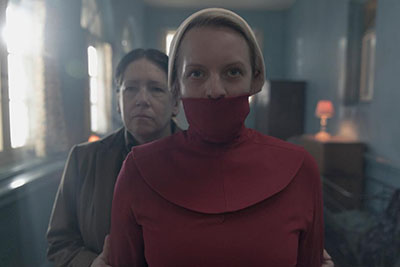The Emmy award-winning dystopian drama, “The Handmaid’s Tale“, released its newest season on June 5, 2019, on the streaming service Hulu. Season three showcased 13 suspenseful and intriguing episodes that further explored the world of Gilead and the main protagonist, June Osborn (Elizabeth Moss), also known as Ofjoseph in this season.
Based on Margaret Atwood’s 1985 book, The “Handmaid’s Tale” takes place in the future where a totalitarian theonomic government, a hypothetical Christian form of government run under divine law, takes over the United States of America in the aftermath of a civil war. An immense drop in fertility rates due to sexually transmitted diseases and environmental pollution caused this civil war.

The country then is called Gilead and comes under the control of power-hungry men. In addition, Gilead enforces newly created social classes and a strict military that keeps a watchful eye on everything and everyone. Women in Gilead are subjugated to work and are not allowed to own property, handle money or read.
With the problem of infertility, the few remaining fertile women are enslaved and called “handmaids,” becoming the property of the elite men and their wives, where they submit to ritualized rape in order to become pregnant and bear children. These women are also called by the prefix “Of-” combined with the first name of the man who ‘owns’ them and uses them for their personal agenda.
The show details the experiences of June Osborn, also known as Offred in season 1 and 2 and then Ofjoseph in season three, and her quest to bring down the totalitarian reign from the inside and get her daughter back from another Gilead family. Season three continues to show her journey and also has a bit more of plotting and action to the series.
Season 3 contained many plot twists and turns and kept viewers on the edge of their seats. It included many new horrors and inspired the hope that a revolution was possible for the future. However, this season also became repetitive, especially in the patterns with the plot from season 2.
The third season did provide background stories on some of the characters like Aunt Lydia, which allowed viewers to become more invested with the show. But it offered little progress for moving the pace.
“The Handmaid’s Tale” is not a show for the faint of heart. It contains mature themes and graphic scenes. Since episodes range from 45 minutes to a little over an hour, a long attention span is necessary to be able to absorb all of the action and information. The show should not be taken lightly because it is also based on historical occurrences that are highlighted in Atwood’s book.
Overall, “The Handmaid’s Tale” deserves the recognition it has received because it is a unique subject for a series. The creator, Bruce Miller, handles the topic in a mature manner but also incorporates lighter and more heartfelt moments to keep viewers watching and wanting more.


























































